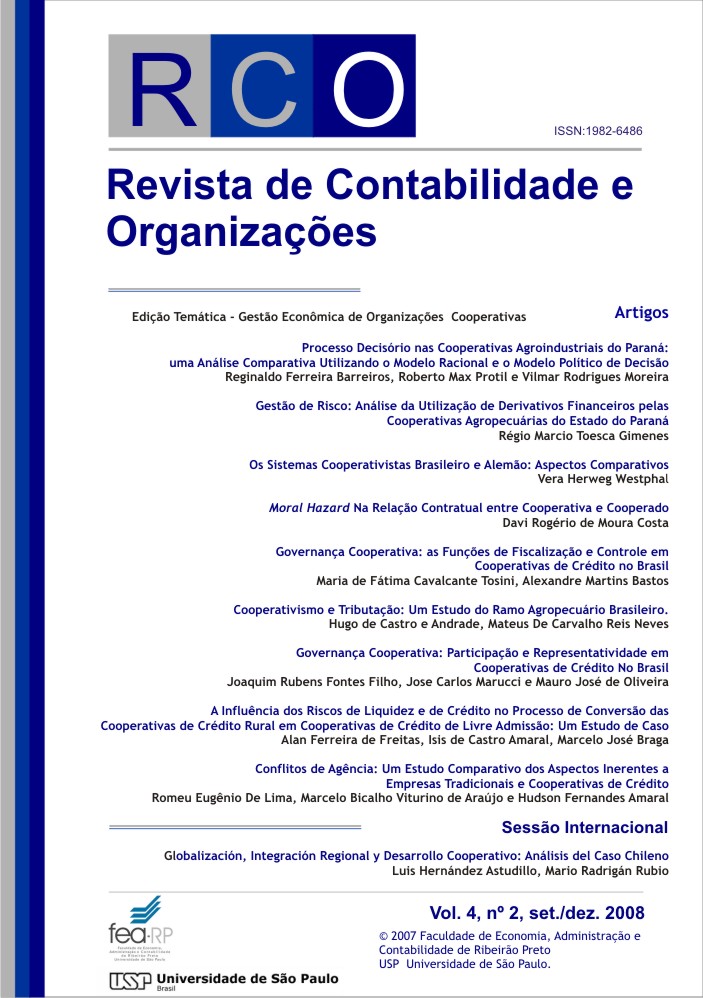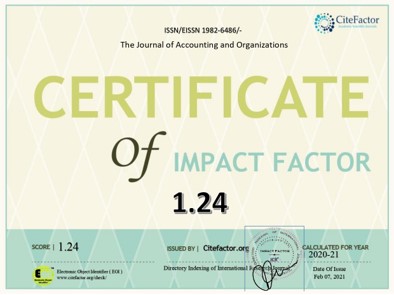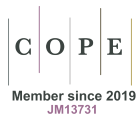A influência dos riscos de liquidez e de crédito no processo de conversão das cooperativas de crédito rural em cooperativas de crédito de livre admissão: um estudo de caso
DOI:
https://doi.org/10.11606/rco.v2i4.34725Palavras-chave:
cooperativa de crédito, processo de conversão, livre admissão, riscosResumo
Este trabalho visa analisar os impactos do processo de conversão de uma cooperativa de crédito rural em cooperativa de crédito de livre admissão, caracterizando os riscos de liquidez e de crédito e a influência dos mesmos na sustentabilidade financeira dessa cooperativa. Optou-se por uma abordagem qualitativa e quantitativa sendo utilizado um estudo de caso da cooperativa Alfha. A análise qualitativa foi elaborada com levantamento de documentos financeiros, aplicação de entrevistas semi-estruturadas e a quantitativa com a utilização de indicadores de solvência, estrutura, liquidez e captação entre os períodos de junho de 2004 a junho de 2007. Como resultado, percebe-se que a cooperativa estudada não deu a devida importância à gestão e análise dos riscos. A conversão implicou em aumento na admissão de tomadores de crédito, e elevação na demanda pelo mesmo, conseqüentemente agravando os riscos. Nos períodos subseqüentes à conversão observa-se a situação de desenquadramento do limite operacional. Neste sentido, a cooperativa comprometeu os recursos financeiros disponíveis para cumprir com as suas obrigações, devido ao aumento no volume das operações de crédito em magnitude superior ao aumento das captações. Conclui-se que o referido processo de conversão demanda uma eficiente política de concessão de crédito e analise de riscos de modo a garantir sustentabilidade financeira da instituição.Downloads
Publicado
Edição
Seção
Licença
A RCO adota a política de Acesso Livre (Libre Open Access), sob o acordo padrão Creative Commons (CC BY-NC-ND 4.0). O acordo prevê que:
- A submissão de texto autoriza sua publicação e implica compromisso de que o mesmo material não esteja sendo submetido a outro periódico. O original é considerado definitivo;
- Autores mantêm os direitos autorais e concedem à revista o direito de primeira publicação, com o trabalho simultaneamente licenciado sob a Licença Creative Commons Attributionque permite o compartilhamento do trabalho com reconhecimento da autoria e publicação inicial nesta revista;
- Autores têm autorização para assumir contratos adicionais separadamente, para distribuição não-exclusiva da versão do trabalho publicada nesta revista (ex.: publicar em repositório institucional ou como capítulo de livro), com necessário reconhecimento de autoria e publicação inicial nesta revista;
- Autores têm permissão e são estimulados a publicar e distribuir seu trabalho online (ex.: em repositórios institucionais ou na sua página pessoal) antes ou durante o processo editorial, já que isso pode gerar alterações produtivas, bem como aumentar o impacto e a citação do trabalho publicado (Veja O Efeito do Acesso Livre);
- A revista não paga direitos autorais aos autores dos textos publicados;
- O detentor dos direitos autorais da revista, exceto os já acordados no acordo de Libre Open Access (CC BY-NC-ND 4.0), é o Departamento de Contabilidade da Faculdade de Economia, Administração e Contabilidade de Ribeirão Preto da Universidade de São Paulo.
Não são cobradas taxas de submissão ou de publicação.
São aceitos até 4 autores por artigo. Casos excepcionais devidamente justificados poderão ser analisados pelo Comitê Executivo da RCO. São considerados casos excepcionais: projetos multi-institucionais; manuscritos resultantes da colaboração de grupos de pesquisa; ou que envolvam grandes equipes para coleta de evidências, construção de dados primários e experimentos comparados.
É recomendada a ordem de autoria por contribuição, de cada um dos indivíduos listados como autores, especialmente no desenho e planejamento do projeto de pesquisa, na obtenção ou análise e interpretação de dados e redação. Os autores devem declarar as efetivas contribuições de cada autor, preenchendo a carta ao editor, logo no início da submissão, responsabilizando-se pelas informações dadas.
É permitida a troca de autores durante todo o processo de avaliação e, antes da publicação do manuscrito. Os autores devem indicar a composição e ordem final de autoria no documento assinado por todos os envolvidos no aceite para publicação. Caso a composição e ordem de autoria seja diferente da informada anteriormente no sistema, todos autores anteriormente listados deverão se manifestar favoráveis.
No caso de identificação de autoria sem mérito ou contribuição (ghost, guest or gift authorship), a RCO segue o procedimento recomendado pela COPE.








